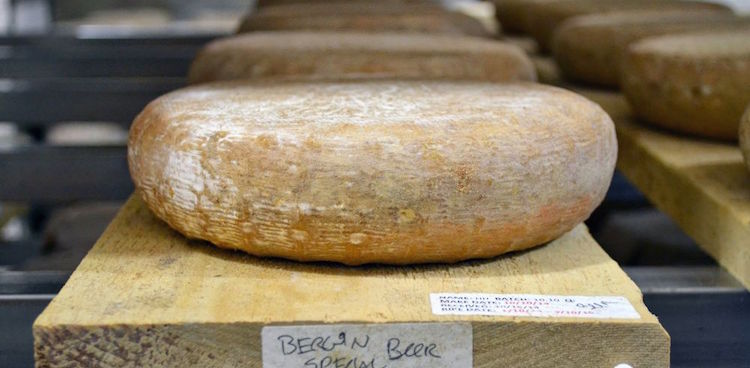
There’s a secret in Crown Heights, Brooklyn. If you take a stroll down Bergen Street, you’ll be be standing atop 10,000 pounds of aging cheese. Originally a brewery, the large building that takes up almost half a city block is now used as a creative space for architects, artists, and food producers. Its accompanying caves are “perfect for aging cheese” according to affineur, or cheese-ager, Sam Frank. The action of aging cheese is called affinage, the process of cheese-ripening. This ripening is what gives blue cheeses their pungent odors and moldy marbled veins; it’s what gives Brie and Camembert their slightly fuzzy rinds. Affinage allows the green moldy splotches on great wheels of cheddar or Alpine cheeses to develop. These caves in Brooklyn, now known commercially as Crown Finish Caves, join the handful of other cheese caves that are allowing American-made cheeses the same tastes and aromas as those traditionally made in natural caves in Europe. Frank, who cares for cheese in the Crown Finish Caves, notes that the building’s history of beer fermenting is great for storing and aging cheese as there are “150 years worth of yeast floating around in the air” of the caves, an ideal addition to luring cheese-loving bacteria and mold (the good kind).

Photo Credit: Caitlin Gunther via Munchies
Though cheese caves are popping up more and more in the United States, they are common in Europe and have been for centuries. The cool, dank environments in natural caves in Italy, France, and other cheesemaking countries are perfect for aging well-known European specimens like Camembert, Roquefort, and Gorgonzola. Cheese caves today, natural or not, aim to not only mimic these perfect natural cave conditions but also regulate them. Ventilation fans ensure proper air circulation while sensor-controlled humidifiers keep the air at moistness levels that can get up to 99.9 percent, as is the case in cheese caves in Minnesota, the Caves of Faribault. Higher humidities are ideal for some Tomme- or Alpine-style cheeses, while other cheeses like a bit dryer conditions, around 90–95%. Temperatures in cheese caves are kept cool, around 50°F, and hygiene is a top priority. In her article for Vice, writer Caitlin Gunther notes that she had to don a “a train conductor hat, a white lab coat, and white Crocs (yikes!)—as well as sanitize any and all of [her] exposed skin—just to descend into the caves.” Cheese-agers do not want any foreign bacteria to come into contact with their cheese babies and mess up the perfectly balanced probiotic cycle.

Photo Credit: Caitlin Gunther via Munchies

Photo Credit: Caitlin Gunther via Munchies
Cheese cave affinage is more than just setting wheels and blocks of cheese on shelves and saying, “See you in a few days (or months. Or years, even)!” Different cheeses have different aging needs: some need constant flipping; others need cleaning; and still other cheeses necessitate “baths”—washing the cheese in different liquids like cider, beer, wine, or brine solutions to bring out different flavors and encourage different mold growth.
In New York City, the renowned Murray’s Cheese Caves take these different cheese needs very seriously. There are even different caves for different types of cheeses: a “washed rind” cave, a “bloomy rind” cave, a “natural rind” cave, and an “Alpine” cave. In fact, Murray’s claims credit for American cheese caves gaining popularity domestically after they opened their first caves in 2004 below Bleaker Street. But the Midwestern cheese-agers of Minnesota’s Caves of Faribault claim an almost more noteworthy title: the first ones to produce a blue cheese in America, named “Treasure Cave Blue” after the Cave’s original name. The Caves of Faribault also boast that they share the same latitude as Roquefort-sur-Soulzon, France, home to the famous Roquefort cheese.

Photo Credit: Murray’s
Craft, artisan, and small-batch cheese-agers are not the only ones profiting from aging their cheeses in caves. Recent news has reported that grocery store Wegman’s has opened its own cheese caves to age much of the cheese it sells to customers. But Wegman’s “cheese caves” aren’t really caves at all, but a “12,000-plus-square-foot building” near Rochester, N.Y., rather than “drippy subterranean spaces.”
The art of cheese-aging has become much more popular as these cheese caves gained renown. And they are only getting bigger. As for the caves under Bergen Street in Brooklyn, the sole cave in use now holds 10,000 pounds of cheese. At full capacity, however, the cheese-agers hope to expand use of other caves under the building, expanding the amount of aging cheese to 100,000 pounds. We can’t wait.
Feature Photo Credit: Caitlin Gunther via Munchies



